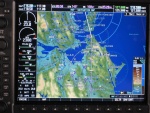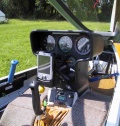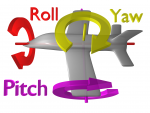If you wish to contribute or participate in the discussions about articles you are invited to contact the Editor
Aviation Applications
| Applications | |
|---|---|
| Title | Aviation Applications |
| Author(s) | GMV. |
| Level | Medium |
| Year of Publication | 2011 |
In aeronautical applications, satellite navigation has long been an additional means for localization purposes. The development of GNSS has provided a supplementary positioning service for many flight phases, in leisure flying as well as commercial air transport. Refining and improving satellite navigation through augmentation systems will assist pilots in all flight phases, from taxing, to take-off, en-route flying, and landing in all weather conditions, reaching the level of safety that will be required to cope with the continuous increase in the number of flights[1].
When planning aircraft routes and landing schedules at busy airports, it is essential to ensure that aircrafts are always a safe distance from each other. GNSS, will provide a guaranteed service with sufficient accuracy to allow airlines and pilots to know their position reliably and precisely enough to make substantial efficiency savings.[2]
Overview of Aviation Applications
GNSS overcomes many of the inadequacies in today’s air traffic infrastructure thanks to its accurate, continuous, all-weather positioning service. This is especially relevant for General Aviation which often uses smaller airports, where the adequate systems represent a large investment.
Total GNSS aviation segment revenues are expected to reach €415 mln in 2020 driven by the increase in general aviation aircraft device sales, that will account for about 98% of the total. GNSS penetration in aviation market is expected to reach 58% by 2015 and 75% by 2020, determined by the SESAR regulation in Europe, accounting for a 100% GNSS penetration by 2020.[3]
The original basic GNSS equipment is evolving due to the development of augmentation systems such as SBAS, GBAS and ABAS, while the introduction of Galileo and the modernization of GPS and GLONASS will further improve GNSS performance. The use of systems that integrate GNSS and inertial systems is also expanding.[4]
The following section provides an overview of augmentation systems used in aviation applications.
GNSS Augmentation
Aviation GNSS applications and products have been one of the main drivers of GNSS Augmentation systems. The ICAO GNSS Standards [5] defines three architectures to augment GNSS constellations for aviation, ABAS (Aircraft Based Augmentation Systems), GBAS (Ground Based Augmentation System) and SBAS (Satellite Based Augmentation System).
Present ground-based navigation aids are monitored, and the monitor takes action if erroneous signals are being radiated. On the present configuration of the GNSS system it may take considerable time before users become aware of any malfunctioning.
ABAS
The Aircraft based augmentation can provide GNSS information as necessary for supplemental means of navigation. An ABAS is basically a system that augments and/or integrates the information obtained from the other GNSS elements with information available on board the aircraft.
The Aircraft based augmentation system can be implemented by:[4]
- Receiver Autonomous Integrity Monitoring (RAIM) whereby a GNSS receiver processor determines the integrity of GNSS position using GPS signals or GPS signals augmented with altitude (baroaiding).
- Aircraft Autonomous Integrity Monitoring (AAIM) whereby the GNSS signal is integrated with other navigation sensors, such as the inertial navigation system (INS) which can perform an integrity check on GNSS data when RAIM is unavailable.
Nowadays, around 70% of European flights are made by aircraft equipped with GPS and RAIM.[6]
GBAS
The GBAS provide GNSS integrity monitoring through data obtained from the ground. They also increase the accuracy of satellite navigation, clearing the way for GNSS precision approach and landing. A ground station at the airport transmits locally-relevant corrections, integrity data and approach data to aircraft at the terminal area in the VHF band. GBAS, will increasingly support CAT II/III operations where economically beneficial once enhanced GNSS become available. It is assumed that all GBAS stations for CAT I operations will be upgraded to CATII/III operations.[7]
Detailed information about GBAS can be found here.
SBAS
SBAS systems implemented in in several regions improves the accuracy, reliability and integrity of the GPS signal. GNSS-SBAS navigators that meet international organizations regulations (such as ICAO, FAA, Eurocontrol) may be used for sole means of navigation for all phases of flight, including precision approach at airports. [8]
The SBAS systems offer an opportunity for airports to gain Instrument Landing System (ILS) approach capability without the purchase or installation of any ground-based navigation equipment at the airport.
The SBAS vertically guided approach procedures are considered LPV (Localizer Performance with Vertical guidance) and provide ILS (Instrument Landing System) equivalent approach minimums as low as 200 feet at qualifying airports. Actual minimums are based on an airport’s current infrastructure, as well as an evaluation of any existing obstructions.[7]
In Europe the EGNOS Safety-of-Life signal was formally declared available to aviation in March 2011. For the first time, space-based navigation signals augmented by this system have become officially usable for the critical task of vertically guiding aircraft during landing approaches. [9]
Detailed information about SBAS can be found here.
GNSS overcomes many of the deficiencies in today’s air traffic infrastructure thanks to its accurate, continuous, all-weather positioning.[2] During en-route flight, the availability of GNSS will ensure high robustness through the redundancy and high reliability of the service.[1]
In the future, higher accuracy and service integrity will allow aircraft separation to be reduced in congested airspace, to cope with traffic growth. GNSS will be used in en-route flight phase of commercial aircraft.
Detailed information about En Route Navigation can be found here.
Approach
Approach, landing and take-off are critical flight phases and the major need of commercial operators is to have full operations in all weather conditions. As a consequence, precision approach is a mandatory requirement.
The GNSS, with the aid of ground-based augmentation (local elements), will satisfy the needs for precision approach as defined in the aeronautical standards, and could replace or complement the navigation infrastructure of airports in regions where the system is inadequate. The most prominent example is the airports that are not equipped with instrument landing systems.
Detailed information about Approach can be found here.
Attitude Determination
The Attitude Determination is one of the many applications where GNSS can be effectively employed.[10]
The attitude of an aircraft, i.e., the orientation in space, can be determined by measuring the relative positions of multiple GNSS antennas mounted on different positions of the aircraft. Usually, a set of 3 or more GNSS antennas placed on board of an aircraft can provide the complete information to compute the aircrft's attitude. [11]
Detailed information about Altitude Determination can be found here.
Air Traffic Control
Air traffic controllers need position, heading, speed and time information for the continuous management of all aircraft. Some areas of the world lack the appropriate ground infrastructure, including secondary radar and communication links. Standardized transmission of GNSS navigation data will lead to advanced systems and techniques for safer air traffic monitoring.
The Automatic dependent surveillance-broadcast (ADS-B) is currently the most important system used in ATC side, which relies on GNSS as primary data source, to obtain aircraft's horizontal positions.
Detailed information about Air Traffic Control can be found here.
Notes
References
- ^ a b Galileo Application Sheet - Aviation Applications, ESA and European Commission, October 2002
- ^ a b ESA Portal - Navigation Applications - Aviation, ESA, June 2007
- ^ GSA GNSS Market Report – Issue 3, October 2010.
- ^ a b Performance-based navigation Manual, ICAO, March 2007
- ^ SARPS Amendment 77, Annex 10 to the Convention on International Civil Aviation, Aeronautical Telecommunications: International Standards and Recommended Practices, Volume 1, Radio Navigation Aids, November 2002.
- ^ EUROCONTROLPolicy on GNSS in Europe, 2009
- ^ a b Federal Aviation Administration Site, Global Positioning System
- ^ Garmin WAAS Certification
- ^ ESA Portal, EGNOS navigation system begins serving Europe’s aircraft
- ^ TUDelft - Attitude Determination and Formation Flying
- ^ Static and dynamic GNSS attitude function testing of airborne equipment, H. Kannemans, National Aerospace Laboratory NLR, April 2005



